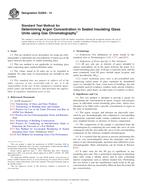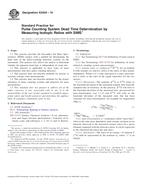Potřebujeme váš souhlas k využití jednotlivých dat, aby se vám mimo jiné mohly ukazovat informace týkající se vašich zájmů. Souhlas udělíte kliknutím na tlačítko „OK“.
ASTM D5185-13e1
Standard Test Method for Multielement Determination of Used and Unused Lubricating Oils and Base Oils by Inductively Coupled Plasma Atomic Emission Spectrometry (ICP-AES) (Includes all amendments And changes 4/12/2018).
Automaticky přeložený název:
Standardní zkušební metoda pro Multielement stanovení použité i nepoužité mazacích olejů a olejů základnu tím, indukčně vázanou plazmou atomovou emisní spektrometrie (ICP-AES)
NORMA vydána dne 15.9.2013
Informace o normě:
Označení normy: ASTM D5185-13e1
Poznámka: NEPLATNÁ
Datum vydání normy: 15.9.2013
Kód zboží: NS-30172
Počet stran: 9
Přibližná hmotnost: 27 g (0.06 liber)
Země: Americká technická norma
Kategorie: Technické normy ASTM
Kategorie - podobné normy:
Fyzikálně chemické analytické metody
Maziva, průmyslové oleje a odpovídající výrobky
Anotace textu normy ASTM D5185-13e1 :
Keywords:
additive-elements, aluminum, barium, boron, calcium, chromium, copper, emission-spectrometry, ICP, inductively coupled plasma atomic emission spectrometry, iron, lead, lubricating oils, magnesium, manganese, molybdenum, nickel, phosphorous, potassium, silicon, silver, sodium, sulfur, tin, titanium, vanadium, wear metals, zinc, ICS Number Code 71.040.50 (Physicochemical methods of analysis), 75.100 (Lubricants, industrial oils and related products)
Doplňující informace
| Significance and Use | ||||||||||||||||||
|
5.1 This test method covers the rapid determination of 22 elements in used and unused lubricating oils and base oils, and it provides rapid screening of used oils for indications of wear. Test times approximate a few minutes per test specimen, and detectability for most elements is in the low mg/kg range. In addition, this test method covers a wide variety of metals in virgin and re-refined base oils. Twenty-two elements can be determined rapidly, with test times approximating several minutes per test specimen. 5.2 When the predominant source of additive elements in used lubricating oils is the additive package, significant differences between the concentrations of the additive elements and their respective specifications can indicate that the incorrect oil is being used. The concentrations of wear metals can be indicative of abnormal wear if there are baseline concentration data for comparison. A marked increase in boron, sodium, or potassium levels can be indicative of contamination as a result of coolant leakage in the equipment. This test method can be used to monitor equipment condition and define when corrective actions are needed. 5.2.1 The significance of metal analysis in used lubricating oils is tabulated in Table 4. 5.3 The concentrations of metals in re-refined base oils can be indicative of the efficiency of the re-refining process. This test method can be used to determine if the base oil meets specifications with respect to metal content. |
||||||||||||||||||
| 1. Scope | ||||||||||||||||||
|
1.1 This test method covers the determination of additive elements, wear metals, and contaminants in used and unused lubricating oils and base oils by inductively coupled plasma atomic emission spectrometry (ICP-AES). The specific elements are listed in 1.2 This test method covers the determination of selected elements, listed in Table 1, in re-refined and virgin base oils. 1.3 For analysis of any element using wavelengths below 190 nm, a vacuum or inert-gas optical path is required. The determination of sodium and potassium is not possible on some instruments having a limited spectral range. 1.4 This test method uses oil-soluble metals for calibration and does not purport to quantitatively determine insoluble particulates. Analytical results are particle size dependent, and low results are obtained for particles larger than a few micrometers.2 1.5 Elements present at concentrations above the upper limit of the calibration curves can be determined with additional, appropriate dilutions and with no degradation of precision. 1.6 For elements other than calcium, sulfur, and zinc, the low limits listed in Table 2 and Table 3 were estimated to be ten times the repeatability standard deviation. For calcium, sulfur, and zinc, the low limits represent the lowest concentrations tested in the interlaboratory study. 1.7 The values stated in SI units are to be regarded as standard. No other units of measurement are included in this standard. 1.8 This standard does not
purport to address all of the safety concerns, if any, associated
with its use. It is the responsibility of the user of this standard
to establish appropriate safety and health practices and determine
the applicability of regulatory limitations prior to use.
Standard Practice for Analysis of Aqueous
Leachates from Nuclear Waste Materials Using Inductively Coupled
Plasma-Atomic Emission Spectroscopy Standard Test Method for Sulfur in
Petroleum Products by High Temperature Combustion and Infrared (IR)
Detection or Thermal Conductivity Detection (TCD) Standard Terminology Relating to
Analytical Chemistry for Metals, Ores, and Related Materials
(Includes all amendments and changes 7/17/2023). Standard Practice for Optimization,
Calibration, and Validation of Inductively Coupled Plasma-Atomic
Emission Spectrometry (ICP-AES) for Elemental Analysis of Petroleum
Products and Lubricants Standard Test Method for Determination of
Additive Elements in Lubricating Oils by Inductively Coupled Plasma
Atomic Emission Spectrometry Standard Test Methods for Elemental
Analysis of Lubricant and Additive Components—Barium, Calcium,
Phosphorus, Sulfur, and Zinc by Wavelength-Dispersive X-Ray
Fluorescence Spectroscopy Standard Test Method for Analysis of
Barium, Calcium, Magnesium, and Zinc in Unused Lubricating Oils by
Atomic Absorption Spectrometry Standard Practice for Manual Sampling of
Petroleum and Petroleum Products Standard Practice for Preparation of
Liquid Blends for Use as Analytical Standards |
Podobné normy:
Historická
1.4.2014
Historická
1.3.2009
Historická
15.6.2013
Historická
1.6.2013
Historická
1.6.2010
Historická
1.5.2014
Doporučujeme:
Aktualizace zákonů
Chcete mít jistotu o platnosti užívaných předpisů?
Nabízíme Vám řešení, abyste mohli používat stále platné (aktuální) legislativní předpisy.
Chcete vědět více informací? Podívejte se na tuto stránku.



 ASTM E2269-14
ASTM E2269-14 ASTM E2310-04(2009)..
ASTM E2310-04(2009).. ASTM E2371-13
ASTM E2371-13 ASTM E2409-13
ASTM E2409-13 ASTM E2426-10
ASTM E2426-10 ASTM E2529-06(2014)..
ASTM E2529-06(2014)..
 Cookies
Cookies
